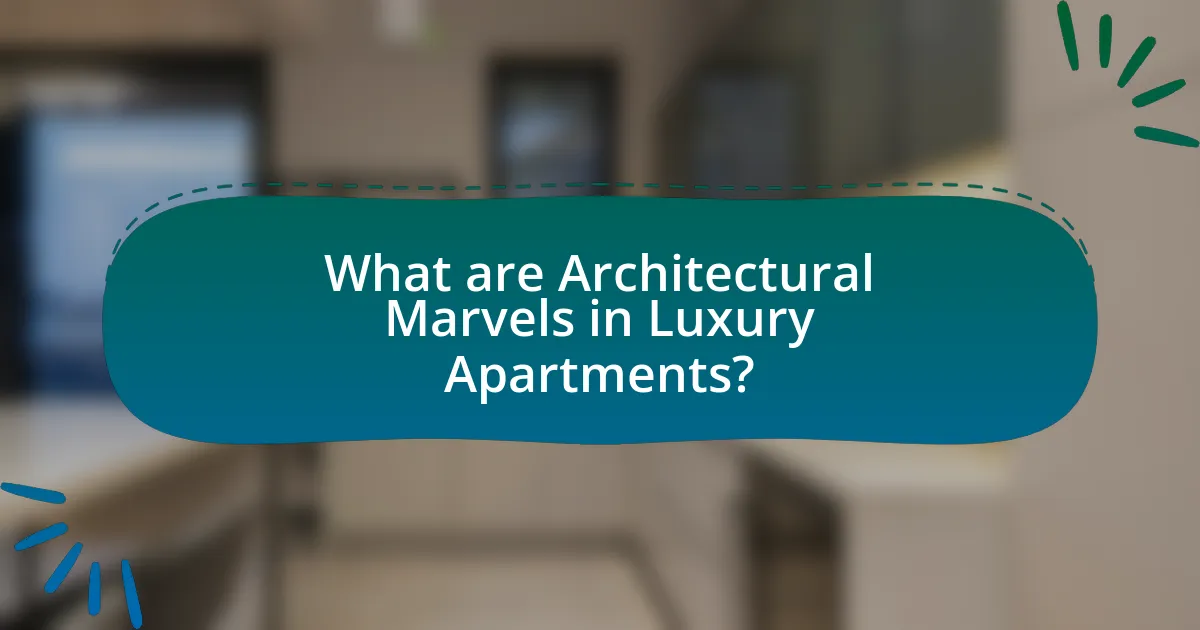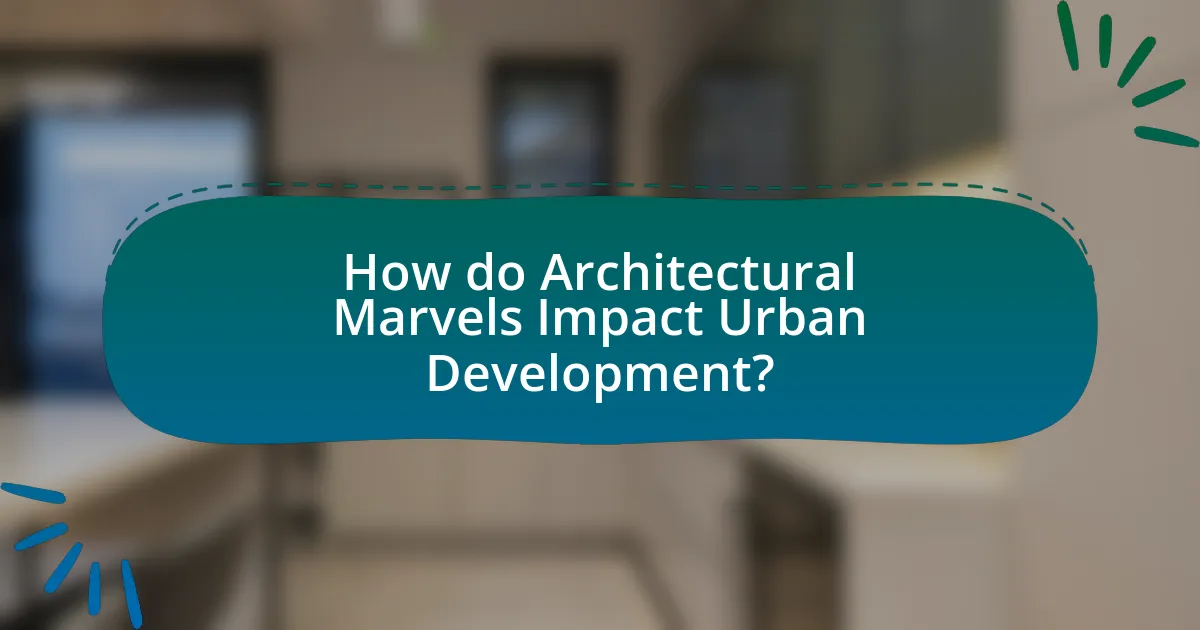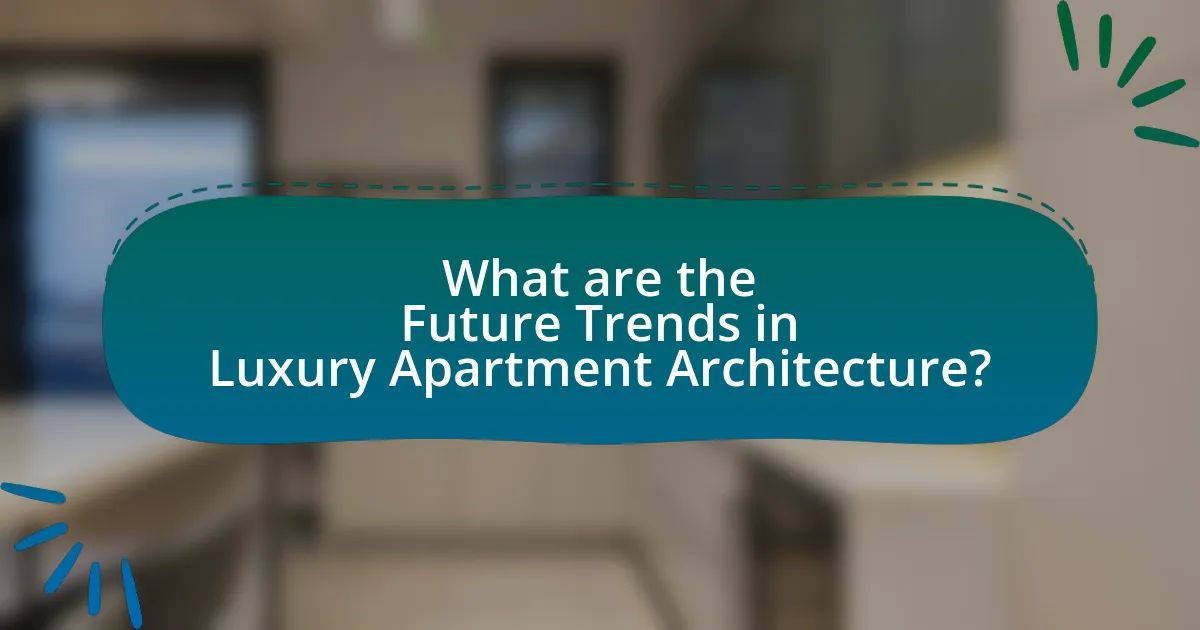Architectural marvels in luxury apartments represent innovative designs that merge aesthetic appeal, advanced engineering, and high-quality materials to create exceptional living spaces. This article explores how architectural designs influence luxury living, highlighting key elements of iconic structures, their historical significance, and their impact on urban development. It examines the unique features of luxury apartments, emerging architectural styles, and the role of sustainability and technology in shaping future trends. Additionally, the article discusses the factors that define luxury in apartment living and the considerations potential buyers should keep in mind when selecting a luxury residence.

What are Architectural Marvels in Luxury Apartments?
Architectural marvels in luxury apartments are innovative designs that combine aesthetic appeal, advanced engineering, and high-end materials to create exceptional living spaces. These structures often feature unique shapes, sustainable technologies, and luxurious amenities, setting them apart from conventional residential buildings. For instance, the Bosco Verticale in Milan showcases vertical gardens that enhance urban biodiversity while providing residents with stunning views and improved air quality. Similarly, the One57 in New York City exemplifies modern luxury with its sleek glass façade and opulent interiors, attracting affluent buyers and redefining urban living.
How do architectural designs influence luxury apartment living?
Architectural designs significantly influence luxury apartment living by shaping aesthetics, functionality, and resident experience. High-end architectural features, such as open floor plans, large windows, and premium materials, enhance the visual appeal and create a sense of spaciousness, which is crucial for luxury living. For instance, buildings designed by renowned architects often incorporate unique elements that not only stand out visually but also provide practical benefits, such as maximizing natural light and optimizing views.
Moreover, luxury apartments often include amenities integrated into the architectural design, such as rooftop gardens, fitness centers, and communal spaces, which foster a sense of community and enhance lifestyle quality. Research indicates that well-designed living spaces can improve residents’ well-being and satisfaction, as seen in studies published in the Journal of Urban Design, which highlight the correlation between architectural quality and resident happiness. Thus, the architectural design of luxury apartments plays a pivotal role in defining the living experience, making it a critical factor in the luxury real estate market.
What are the key elements of iconic architectural designs?
The key elements of iconic architectural designs include innovation, functionality, aesthetics, and cultural significance. Innovation drives the use of new materials and technologies, exemplified by structures like the Burj Khalifa, which utilizes advanced engineering techniques. Functionality ensures that designs meet the needs of their users, as seen in the adaptable spaces of the High Line in New York City. Aesthetics contribute to visual appeal, often characterized by unique shapes and forms, such as the Guggenheim Museum in Bilbao, which features a distinctive organic design. Cultural significance reflects the historical and social context of a building, as demonstrated by the Sydney Opera House, which symbolizes Australia’s identity. These elements collectively contribute to the lasting impact and recognition of iconic architectural works.
How do these designs enhance the living experience?
These designs enhance the living experience by integrating functionality with aesthetic appeal, creating spaces that promote comfort and well-being. For instance, luxury apartments often feature open floor plans, large windows for natural light, and high-quality materials, which contribute to a sense of spaciousness and tranquility. Research indicates that well-designed living environments can improve mental health and overall satisfaction, as seen in studies showing that access to natural light and views of nature can reduce stress levels and enhance mood.
Why are luxury apartments considered architectural marvels?
Luxury apartments are considered architectural marvels due to their innovative design, high-quality materials, and integration of advanced technology. These residences often feature unique architectural styles that push the boundaries of conventional design, exemplified by iconic buildings like the Burj Khalifa in Dubai, which stands as the tallest structure in the world and showcases cutting-edge engineering. Additionally, luxury apartments frequently incorporate sustainable building practices, such as energy-efficient systems and eco-friendly materials, further enhancing their status as architectural achievements. The combination of aesthetic appeal, functionality, and sustainability solidifies their reputation as marvels in the field of architecture.
What historical significance do these buildings hold?
These buildings hold historical significance as representations of architectural innovation and cultural identity. For instance, structures like the Bauhaus in Germany symbolize the modernist movement, influencing design principles globally. Additionally, iconic luxury apartments such as The Dakota in New York City reflect the socio-economic changes of their time, serving as residences for prominent figures and shaping urban landscapes. Their unique designs and historical contexts contribute to their status as landmarks, preserving the narratives of the eras in which they were built.
How do luxury apartments reflect cultural values and trends?
Luxury apartments reflect cultural values and trends by embodying the aspirations, lifestyles, and aesthetics of their respective societies. For instance, in urban environments, luxury apartments often prioritize open spaces and modern design, reflecting a trend towards minimalism and sustainability, which aligns with contemporary values of environmental consciousness. Additionally, the incorporation of smart home technology in luxury apartments showcases a cultural shift towards innovation and convenience, catering to the demands of a tech-savvy population. Historical examples include the Art Deco movement in the 1920s, where luxury apartments featured ornate designs that mirrored the era’s fascination with glamour and sophistication, illustrating how architectural styles can signify broader cultural movements.
What are some examples of iconic luxury apartments worldwide?
Some examples of iconic luxury apartments worldwide include One57 in New York City, the Burj Khalifa Residences in Dubai, and The Shard Residences in London. One57, completed in 2014, features stunning views of Central Park and is known for its high-end amenities, including a private concert hall. The Burj Khalifa Residences, located in the tallest building in the world, offer unparalleled luxury and access to exclusive services. The Shard Residences, situated in a landmark skyscraper, provide breathtaking views of the London skyline and are designed with modern elegance. These apartments are recognized for their architectural significance and luxurious living experiences.
Which cities are known for their architectural luxury apartments?
Cities known for their architectural luxury apartments include New York City, London, Dubai, Hong Kong, and Paris. New York City features iconic luxury buildings like One57 and The Edge, showcasing modern design and high-end amenities. London is home to luxury developments such as The Shard and One Hyde Park, known for their unique architecture and prime locations. Dubai boasts architectural marvels like the Burj Khalifa and luxury apartments in developments like Palm Jumeirah, emphasizing innovative design. Hong Kong’s skyline includes luxury apartments in buildings like The Peak and 39 Conduit Road, renowned for their stunning views and architectural excellence. Paris offers luxury living in historic buildings and modern designs, with developments like La Samaritaine and Les Jardins de la Lune, blending classic and contemporary styles.
What unique features do these apartments offer?
These apartments offer unique features such as panoramic city views, state-of-the-art smart home technology, and exclusive amenities like rooftop gardens and private pools. For instance, many luxury apartments are designed with floor-to-ceiling windows that provide unobstructed views of the skyline, enhancing the living experience. Additionally, smart home systems allow residents to control lighting, temperature, and security remotely, adding convenience and modernity. Exclusive amenities, such as rooftop gardens, provide residents with private outdoor spaces for relaxation and social gatherings, while private pools offer a luxurious retreat within the building.

How do Architectural Marvels Impact Urban Development?
Architectural marvels significantly influence urban development by attracting investment, enhancing property values, and shaping city identity. For instance, iconic structures like the Burj Khalifa in Dubai have stimulated economic growth by drawing tourism and business, resulting in a 20% increase in property values in the surrounding area. Additionally, these landmarks often lead to improved infrastructure and urban planning, as cities invest in transportation and public spaces to accommodate increased foot traffic and enhance accessibility. This transformation not only revitalizes neighborhoods but also fosters a sense of community and pride among residents, ultimately redefining the urban landscape.
What role do luxury apartments play in city landscapes?
Luxury apartments significantly enhance city landscapes by contributing to urban aesthetics, economic growth, and social dynamics. These high-end residential buildings often feature innovative architectural designs that become landmarks, attracting tourism and elevating the visual appeal of neighborhoods. For instance, iconic structures like the One57 in New York City not only redefine skylines but also increase property values in their vicinity, demonstrating their economic impact. Furthermore, luxury apartments often foster a sense of exclusivity and community among affluent residents, influencing local culture and lifestyle. This multifaceted role underscores the importance of luxury apartments in shaping modern urban environments.
How do they contribute to urban aesthetics?
Iconic luxury apartments contribute to urban aesthetics by enhancing the visual appeal and character of cityscapes. Their innovative designs, often characterized by unique architectural styles and high-quality materials, create striking silhouettes that stand out against traditional buildings. For instance, the use of glass facades in luxury apartments reflects light and surroundings, adding dynamism to the urban environment. Additionally, these structures often incorporate green spaces and art installations, promoting a harmonious blend of nature and urban life, which has been shown to increase property values and attract tourism.
What are the economic impacts of luxury apartments on local communities?
Luxury apartments can significantly impact local communities by increasing property values and generating higher tax revenues. The presence of luxury developments often leads to gentrification, where existing residents may be displaced due to rising costs, while new businesses catering to affluent residents emerge, stimulating local economies. For instance, a study by the National Association of Realtors found that luxury apartment developments can raise surrounding property values by up to 20%. Additionally, luxury apartments typically contribute to local tax bases, providing funding for public services and infrastructure improvements.
How do these buildings influence real estate markets?
Iconic luxury apartments significantly influence real estate markets by driving demand and increasing property values in their respective areas. These buildings often attract affluent buyers and investors, leading to a surge in interest for nearby properties. For instance, the presence of high-end developments like One57 in New York City has been linked to a rise in property prices in the surrounding neighborhoods, with some reports indicating price increases of up to 30% in adjacent areas. Additionally, these architectural marvels can enhance the overall appeal of a location, making it more desirable for both residential and commercial investments, thereby reshaping market dynamics.
What trends are emerging in luxury apartment developments?
Emerging trends in luxury apartment developments include a focus on sustainability, smart home technology, and wellness amenities. Developers are increasingly incorporating eco-friendly materials and energy-efficient systems to meet the growing demand for sustainable living. For instance, a report by the Urban Land Institute highlights that 70% of luxury buyers prioritize sustainability features in their purchasing decisions. Additionally, the integration of smart home technology, such as automated lighting and security systems, enhances convenience and security for residents. Furthermore, wellness amenities like fitness centers, yoga studios, and green spaces are becoming standard, as studies show that access to such facilities can significantly improve residents’ quality of life.
How do luxury apartments affect property values in their vicinity?
Luxury apartments generally increase property values in their vicinity. This phenomenon occurs due to several factors, including enhanced neighborhood desirability, improved local amenities, and increased demand for housing in upscale areas. For instance, a study by the National Association of Realtors found that luxury developments can raise surrounding property values by as much as 20% due to the perception of prestige and improved infrastructure. Additionally, luxury apartments often attract affluent residents, which can lead to higher spending in local businesses and further investment in the area, thereby driving up property values.

What are the Future Trends in Luxury Apartment Architecture?
Future trends in luxury apartment architecture include a focus on sustainability, smart technology integration, and wellness-oriented design. Sustainability is becoming paramount, with architects increasingly utilizing eco-friendly materials and energy-efficient systems to reduce environmental impact. For instance, the use of green roofs and solar panels is on the rise, reflecting a commitment to sustainable living.
Smart technology integration is also a significant trend, as luxury apartments are incorporating advanced home automation systems that enhance convenience and security. Features such as smart lighting, climate control, and integrated security systems are becoming standard, appealing to tech-savvy residents.
Additionally, wellness-oriented design is gaining traction, with architects prioritizing natural light, open spaces, and amenities that promote health and well-being, such as fitness centers and communal gardens. This trend is supported by research indicating that environments designed with wellness in mind can improve residents’ quality of life.
Overall, these trends reflect a shift towards creating luxurious living spaces that are not only aesthetically pleasing but also environmentally responsible and conducive to a healthy lifestyle.
How is sustainability shaping luxury apartment designs?
Sustainability is significantly shaping luxury apartment designs by integrating eco-friendly materials, energy-efficient systems, and innovative technologies. Luxury apartments now often feature sustainable building materials such as reclaimed wood, recycled steel, and low-VOC paints, which reduce environmental impact. Additionally, energy-efficient systems like solar panels and smart home technologies are increasingly incorporated to minimize energy consumption and enhance residents’ comfort. According to a report by the World Green Building Council, buildings that prioritize sustainability can reduce energy use by up to 50%, demonstrating the tangible benefits of these design choices.
What innovative technologies are being integrated into these buildings?
Innovative technologies integrated into luxury apartments include smart home automation systems, energy-efficient building materials, and advanced security features. Smart home automation allows residents to control lighting, heating, and security systems remotely, enhancing convenience and energy management. Energy-efficient materials, such as high-performance insulation and solar panels, contribute to sustainability and lower utility costs. Advanced security technologies, including biometric access controls and surveillance systems, ensure resident safety. These technologies collectively enhance the living experience while promoting sustainability and security in architectural marvels.
How do eco-friendly designs enhance luxury living?
Eco-friendly designs enhance luxury living by integrating sustainable materials and energy-efficient technologies that elevate both comfort and aesthetic appeal. These designs often feature high-quality, natural materials such as reclaimed wood and stone, which not only reduce environmental impact but also provide a unique, sophisticated look. Additionally, luxury apartments with eco-friendly designs frequently incorporate advanced systems like solar panels and smart home technologies, which contribute to lower utility costs and a reduced carbon footprint. According to a study by the World Green Building Council, green buildings can achieve up to 30% energy savings compared to conventional buildings, demonstrating that sustainability can coexist with luxury.
What are the emerging architectural styles in luxury apartments?
Emerging architectural styles in luxury apartments include biophilic design, minimalist aesthetics, and adaptive reuse. Biophilic design integrates natural elements, such as greenery and natural light, to enhance residents’ well-being, reflecting a growing trend towards sustainability and connection with nature. Minimalist aesthetics focus on simplicity and functionality, often featuring open spaces and clean lines, which cater to modern lifestyles. Adaptive reuse involves transforming existing structures into luxury living spaces, preserving historical elements while incorporating contemporary amenities, thus promoting sustainability and cultural heritage. These styles are increasingly popular as they align with current lifestyle preferences and environmental considerations.
How do these styles reflect changing consumer preferences?
Architectural styles of luxury apartments reflect changing consumer preferences by prioritizing sustainability, technology integration, and personalized living experiences. For instance, the rise of eco-friendly designs, such as green roofs and energy-efficient materials, indicates a growing consumer demand for environmentally responsible living spaces. According to a 2021 survey by the National Association of Home Builders, 70% of homebuyers expressed a preference for energy-efficient features, showcasing a significant shift towards sustainability in consumer choices. Additionally, the incorporation of smart home technology in luxury apartments aligns with the increasing consumer desire for convenience and connectivity, as evidenced by a report from Statista indicating that the smart home market is projected to reach $174 billion by 2025. These trends illustrate how architectural styles are evolving to meet the dynamic preferences of modern consumers.
What can we expect in the next decade for luxury apartment architecture?
In the next decade, luxury apartment architecture will increasingly prioritize sustainability, advanced technology, and wellness-oriented design. Architects will integrate eco-friendly materials and energy-efficient systems to meet growing environmental concerns, as evidenced by the rise of green building certifications like LEED, which has seen a 50% increase in projects since 2010. Additionally, smart home technologies will become standard, enhancing security and convenience through automation, reflecting a trend where 70% of new luxury developments are expected to incorporate smart features by 2030. Lastly, designs will focus on promoting health and well-being, with amenities such as fitness centers, green spaces, and natural light, aligning with research indicating that access to nature and wellness facilities significantly improves residents’ quality of life.
What should potential buyers consider when choosing a luxury apartment?
Potential buyers should consider location, amenities, and building quality when choosing a luxury apartment. The location impacts lifestyle, accessibility, and potential resale value; for instance, properties in prime urban areas often appreciate faster. Amenities such as fitness centers, pools, and concierge services enhance living experiences and can differentiate luxury offerings. Additionally, the building quality, including construction materials and design, affects durability and maintenance costs, with high-quality buildings typically requiring less upkeep and providing better long-term value.
How do location and amenities influence the decision-making process?
Location and amenities significantly influence the decision-making process by determining the desirability and perceived value of luxury apartments. A prime location, such as proximity to cultural landmarks, business districts, and transportation hubs, enhances the appeal of a property, making it more attractive to potential buyers or renters. For instance, luxury apartments in urban centers often command higher prices due to their accessibility and status. Additionally, amenities such as fitness centers, pools, and concierge services contribute to the overall living experience, impacting buyer preferences. Research indicates that 70% of homebuyers prioritize location and amenities when selecting a property, underscoring their critical role in decision-making.
What are the key factors that define luxury in apartment living?
The key factors that define luxury in apartment living include high-quality materials, exceptional design, exclusive amenities, and prime locations. High-quality materials such as marble, hardwood, and custom finishes contribute to an upscale aesthetic and durability. Exceptional design often features open floor plans, large windows for natural light, and innovative layouts that enhance livability. Exclusive amenities like concierge services, fitness centers, rooftop terraces, and swimming pools elevate the living experience, providing residents with convenience and leisure. Prime locations in desirable neighborhoods or urban centers ensure accessibility to cultural, dining, and entertainment options, further enhancing the luxury appeal. These factors collectively create an environment that embodies sophistication and comfort, making luxury apartments highly sought after.

